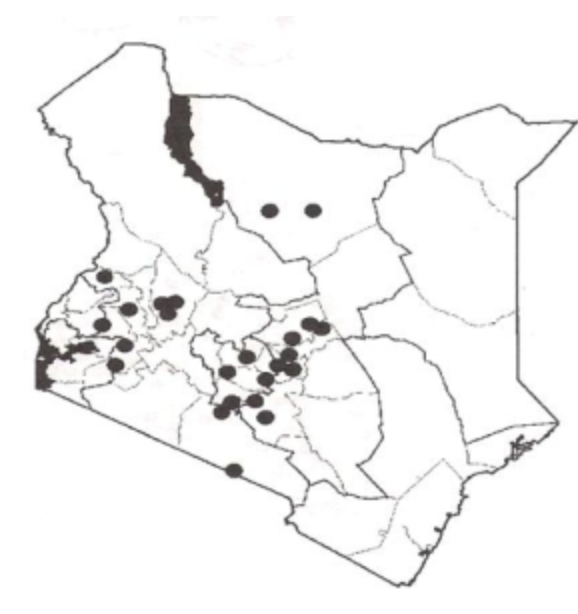
(c) Bo Tengnas
1. Introduction
General distribution:
Cordia Abyssinica is distributed from Guinea in W. Africa east to Ethiopia to S. Africa. It is also found in the Arabian Peninsula. It is widespread in Kenya where is common in pastures mainly in Central Province, around Nairobi, in Meru, Marsabit, Kakamega, and Kisii Districts and in parts of Rift Valley Province.

(c) Maundu P. and Bo Tengnas. (2005). Useful trees and shrubs for Kenya, World Agroforestry Centre.
General Information about the Tree:
The heartwood is hard and takes a good polish, so the timber is prized for furniture, but it can be twisted and difficult to saw. Often found in cropland where it is managed to reduce shade. Provides very good mulch.
A large deciduous forest tree of moist warm areas, woodland and bush. Widespread in Kenya, common in pasture land between 1,200 and 2,000 m. mainly in Central Province, around Nairobi, in Meru, Marsabit, Kakamega, and Kisii Districts and in parts of Rift Valley Province. Tends to be riverine in drier areas. Ecozones II – III.
Biophysical Limits:
C. Africana is widespread in Kenya, common in pasture land between 1,200 and 2,000 m above sea level. Mean annual rainfall: 700-2, 000 mm and soil type: Large leafed cordia thrives in forest soil. It tends to be riverine in drier areas and found in agro-ecological zones II – III.
Management System: Plantation, mixed woodlots, amenity, agroforestry
Tree Management: Propagation; wildings and seedlings. Moderate to slow growing; taking 30 – 60 yrs to mature. Pollarding, lopping and coppicing may be applied. Several seedlings may germinate from each stone. Can be pricked out. Young trees grow best under some shade. Tend to branch a lot if grown in full light. This tree may exist in plantations, mixed woodlots, agroforestry and may also be used for amenity purposes in homes or on streets.
Products:
As the name suggests (Multipurpose), this tree has many uses which include but not limited to the following;
- Timber: is used for high-quality furniture, doors, windows, cabinet making, drums, beehives, joinery, interior construction, mortars, paneling and veneering.
- Fuel: it is a good source of firewood.
- Food: when mature, fruits have a sweet, mucilaginous, edible pulp.
- Medicine: fresh, juicy bark can be used to tie a broken bone; this splint is changed occasionally with a fresh one until the bone is healed.
- Fodder: source of animal feed in dry season.
- Apiculture: It is a good source of bee forage, as the flowers yield plenty of nectar. Beehives are often placed in the trees.